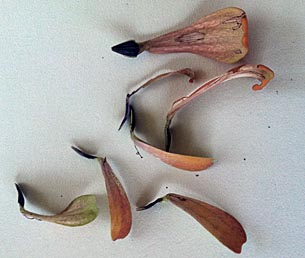Cheap Thrills: Learning to Save Seeds
By Marsha Goldberg, Fairfax Master Gardener Intern
My garden is awash with color this year. Zinnias, sunflowers, cosmos and coreopsis–all charming on their own–are attracting crowds of butterflies, goldfinches and hummingbirds. It is my most beautiful and productive garden yet, but it is especially satisfying because most of the flowers and vegetables grew from seeds that I saved from last year’s garden.
Saving seeds is a satisfying hobby that not only makes me feel like an accomplished gardener, but a budget-savvy one, too, because I don’t have to buy seeds year after year. The colorful flowers that spring from the seeds I saved are not only beautiful, they attract pollinators who work on increasing my yield of vegetables (which, by the way, I also grow from saved seeds).

Black arrowhead-shaped seeds of a zinnia. The dried out orange petals are still attached.
To harvest seeds, wait for the flower to dry. The arrowhead-shaped seeds of zinnias are at the base of the petals, as are the seeds of marigolds and cosmos, and will be obvious once the petals dry out. Tiny coreopsis seeds will be in the cone-shaped center of the petals. As for sunflowers, once the head has dried out, look for large black seeds in the flower’s center, after you brush away the greenish-yellow fuzz that covers them (if you can get to them before the goldfinches do!) Each flower is a bit different. You can put a handful of dried flower heads in a brown-paper bag and shake it gently; the seeds will usually fall out. Separate the seeds from the chaff, or dried-out petals, stem and leaf parts. Label and store them in a jar, or wrap them in paper and place them in a container. Be sure to keep them in a cool, dry location over the winter.
Vegetables can be a bit trickier because you need to know whether your plants are from heirloom or hybrid seeds. Seed companies, through the years, have worked to improve the vegetables they offer customers by creating hybrid plants. A breeder might, for instance, cross a tomato that has great color and flavor but poor disease resistance with a tomato that has less flavor but is not bothered by common tomato diseases such as verticillium fungus or fusarium wilt. If you can remember your seventh-grade science lessons, you know that the next year about 25 percent of the tomatoes will be disease-resistant and taste wonderful, 25 percent will be disease-prone and lack great flavor, and the rest will be somewhere in between. The breeder will continue to select the best tomatoes each year for seeds. However, these seeds will often produce plants that revert to the characteristics of the parent plant, so the characteristics are not stable. While the breeder can continuously select and breed the best plants, the home-gardener may end up with plants that are not what he or she was hoping to get.
Open-pollinated or heirloom seeds do not have this problem because they are not hybrids, and the characteristics remain true. While they may be a bit more difficult to grow because they are often not as disease resistant, heirlooms are known for their superior taste and are usually grown for this reason. An added benefit is that the seeds are better for saving than those from hybrid plants.
Additionally, some plants, such as tomatoes, are self-pollinated. That means that the plant contains both the stamen and the pistils, the female and male parts of the plant, so it can pollinate itself inside the flower, and the characteristics remain true. Other plants must be cross-pollinated and rely on insects, birds or the wind to pollinate them. Since this can result in plants cross-breeding, similar to what happens during hybridizing, the characteristics of plants grown from the resulting seeds may also vary.
Because of the issues with hybridization and pollination, the easiest vegetable seeds to save are those from beans, peas, peppers, eggplants and heirloom tomatoes. Like flowers, wait for the bean and pea pods to dry out before collecting the seeds. You can collect seeds from peppers, eggplants, and tomatoes once they are ripe. Many seed savers soak tomato seeds in water for about three days to let them ferment, which will dissolve the gelatinous coating that prevents them from sprouting inside the tomato but others don’t give tomato seeds any special treatment. Whichever method you use, rinse the seeds off well, and let them dry thoroughly. Like flower seeds, you should store them in a cool dry place.
Resources
Seed For the Garden, Virginia Cooperative Extension
An Introduction to Seed Saving for the Home Gardener, University of Maine